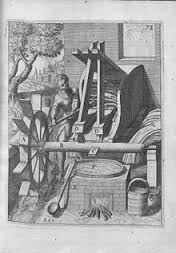In 1523 the lake craft of Hasselt built a fulling mill on the Stiemerbeek: the Slagmolen in Genk (Belgium). There was felt made from wool.
From 1645 there were made cords of flax and hemp, and oil from rape seed. From 1843 to 1955 it was a flour mill. After restoration, he is again in operation since 1986.
 Fulling is a finishing of woven woolen fabric which greatly improves the quality by making the tissue structure closer and firmer (matted, felted). This results in a sturdy, waterproof fabric that is less susceptible to shrinkage.
Fulling is a finishing of woven woolen fabric which greatly improves the quality by making the tissue structure closer and firmer (matted, felted). This results in a sturdy, waterproof fabric that is less susceptible to shrinkage.
Traditionally, the tissue is immersed in hot water, urine, soap and fuller's earth: a fatty clay which absorbs the dirt from the fiber. To fulling the fabric was hours, even days for some qualities, kneaded. Through stamping the tissue (e.g. with feet) the fabric will felt and shrink. Fulling is heavy and dirty work. Since the 17th century this work was mechanized in fulling mills, also known as stink mills.
